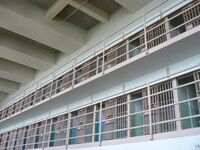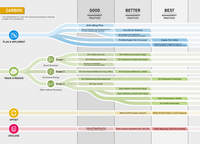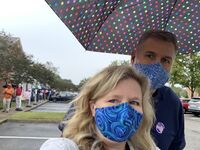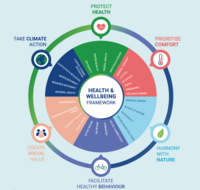News Brief
“Ready to Respond” helps affordable housing organizations set up an emergency business continuity plan to aid leadership, staff, and residents.
When disaster strikes, affordable housing organizations have unique resilience problems to address—like ensuring their often-vulnerable residents remain continuously housed. “Ready to Respond” (R2R) is a staffing toolkit designed to help affordable housing organizations anticipate and smoothly respond to climate risks and... Read more
Spotlight Report
For decades, designers have fought for sustainability to be incorporated into building codes and standards. Is it time to do the same for resilience?
This report takes a look at how some cities are changing their planning, zoning, and building codes to ensure that their life safety measures still hold up in the face of climate change and... Read more
News Brief
Just before leaving office, Trump signed the most important climate legislation in a decade.
The last four years have been a disaster for the U.S. environment, with the Trump administration rolling back vital environmental protections and promoting fossil fuel industries that have no viable business future.
Yet tucked into the sprawling COVID-19 relief bill that was signed by President Trump on December 27, 2020, is... Read more
News Analysis
We spoke with Ed Mazria about everything from the 1970s energy crisis to the current climate crisis—and heard a message of hope.
The American Institute of Architects (AIA) gives out the Gold Medal each year, typically to acknowledge a body of influential architectural work. This year was a little different, stretching the boundaries of what the Gold Medal is all about. Ed Mazria, FAIA, received the award for 2021—not mainly for his work in practice, but... Read more
Infographic
It has been quite a wild ride! As The BuildingGreen Report (formerly Environmental Building News, or “EBN”) celebrates its 30th year of publication, we decided to track the growth—and explosion—of the green building movement. We start in 1990 with the founding of AIA’s Committee on the Environment.
There is so much more that we could... Read more
News Brief
The Green Real Estate Sustainability Benchmark has left GBCI to become more independent.
Green building portfolios are big business. They are proven to perform better financially, so investors want to know if the real estate assets they invest in are sustainably built and operated. Sustainability scores from GRESB (the Green Real Estate Sustainability Benchmark) for many years have been the best way for investors to find this out.... Read more
News Analysis
Buildings, streets, and other hard surfaces are at the root of many sustainability issues and associated inequities. The Smart Surfaces Coalition is looking to change that.
Asthma-inducing smog, heat-related deaths, persistent flooding that causes mold, high energy costs. We hear a lot about all these problems. Often missing from the conversation? The people who bear the biggest burdens typically live in low-income neighborhoods and other marginalized communities. Greg Kats, co-founder of the... Read more
News Brief
Four cities have committed to halving construction emissions by 2030, focusing on embodied carbon and zero-carbon equipment.
Is the world ready for electric backhoes? Mayors of four cities say they soon will be—and that they will go even further by halving the embodied carbon emissions of building and infrastructure projects not long after.
C40, a coalition of 97 megacities around the world, has rolled out a Clean... Read more
Webcast
Every year for the past 19 years, BuildingGreen has selected ten green building products that significantly improve upon standard “business-as-usual” practices. This year’s products address our most pressing challenge: reducing the environmental impacts of greenhouse gases. The winning products do so by sequestering carbon, conserving energy... Read more
News Brief
The Rocky Mountain Institute has received $10 million from the Bezos Earth Fund for its building and industry decarbonization efforts.
The Rocky Mountain Institute (RMI) has received a $10 million grant from the new Bezos Earth Fund, which was founded with the goal of mitigating climate change.
Eighty percent of the funding will go toward RMI’s Carbon-Free Buildings campaign. This initiative advocates for all-electric new... Read more
Product Review
These innovative products reduce carbon emissions and include negative embodied carbon carpet, repurposed EV battery storage, carbon sequestering aggregate, and more.
Every year for the past 19 years, BuildingGreen has selected ten green building products that significantly improve upon standard “business-as-usual” practices. This year’s products address our most pressing challenge: reducing the environmental impacts of greenhouse gases. The following products do so by sequestering carbon, conserving energy... Read more
News Brief
In a major policy shift, the American Institute of Architects bans its members from designing places for execution, torture, and solitary confinement.
In its 2020 revision of its Code of Ethics, released on December 11, 2020, the American Institute of Architects (AIA) adopted two new rules: Rule 1.403 against the design of spaces intended for execution, and Rule 1.404 against the design of “spaces intended for torture, including indefinite or prolonged solitary confinement... Read more
News Brief
The United Nations has awarded Interface for climate action in light of its new product and its overall Climate Take Back commitment.
Tons and tons of carpet can go into a single building project—only to be ripped out and replaced a few years down the road. Carpet is almost always a fossil-fuel-based product and rarely gets reused or recycled. Its carbon footprint accumulates over the lifetime of a building as the carpeting is replaced multiple times.
... Read moreNews Brief
Touching on issues from jobsite health to climate change, the new commitment helps contractors pursue sustainability goals.
How does a general contractor track and measure its firm-wide sustainability? The Sustainable Construction Leaders group (a BuildingGreen-supported peer network) is trying to work that out. Its new initiative, the Contractor’s Commitment, provides a framework, and building contractors can soon sign on for the 2021 pilot.... Read more
Feature
The Biden-Harris administration may be the most important ever relative to the environment.
With a new president and the first-ever woman vice president starting next month, we thought it would be an opportune time to weigh in on priorities for the next four years.
It has been a rough four years for the environment with the Trump administration. How can our nation get back on track in addressing some of the most pressing... Read more
News Brief
A new WorldGBC framework challenges those prioritizing health and wellness to think beyond the building occupant.
Improving “health and wellbeing” through the built environment has often been code for improving outcomes for just one type of person—the office worker. The emphasis on bettering health in order to boost productivity has left other areas “underdeveloped,” according to the World Green Building Council (WorldGBC). For a more... Read more
Webcast
With the introduction of LEED v4.1, it’s now possible to do an unlimited number of one-off credit substitutions. In this webcast, Tommy Linstroth of Green Badger gives you an essential playbook for deciding which construction-related credits to upgrade.
Moving through the system credit by credit, Tommy shows you step by step what’s... Read more
Product Review
Due to regulatory changes in Canada and certain U.S. states, manufacturers will be offering XPS with low global warming potential starting in 2021.
BuildingGreen’s 2010 article Avoiding the Global Warming Impact of Insulation caused quite a stir in the industry by positing that it can take decades to “pay back” the greenhouse gases contained in extruded polystyrene insulation. That’s because despite XPS’s excellent thermal performance, its primary blowing agent, HFC-134a... Read more
News Analysis
The NOMA/NAACP/SEED Awards for this year highlight projects with a social justice mission.
You know about LEED, but what about SEED?
Although Design Corps’ Social, Economic, and Environmental Design (SEED) program has been around for more than a decade, it’s less well known than other rating systems. But with the green building world gradually waking up to its equity challenges, SEED is starting to gain more traction and... Read more
News Analysis
USGBC will start integrating more equity elements into the LEED rating systems and beyond.
“A sustainable future is meaningless if it is not also an equitable future.”
That’s the bold statement made on the U.S. Green Building Council (USGBC) website to introduce a new 12-point strategy called “All In.” The idea is to close equity gaps in the LEED rating systems, which have traditionally... Read more










